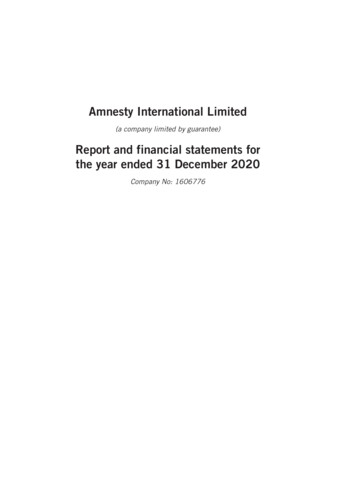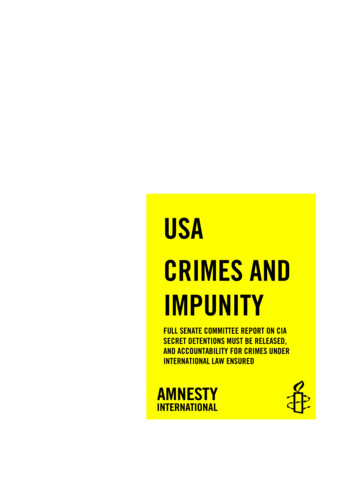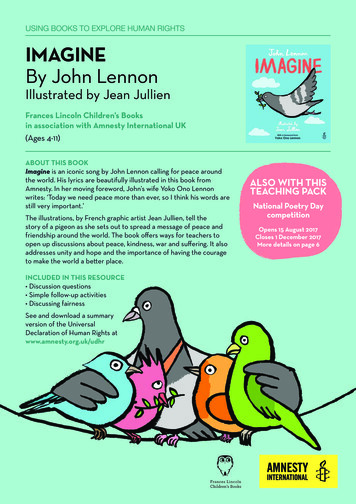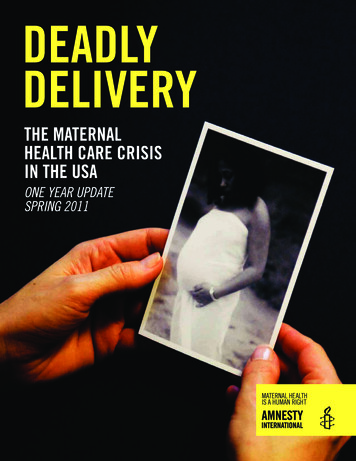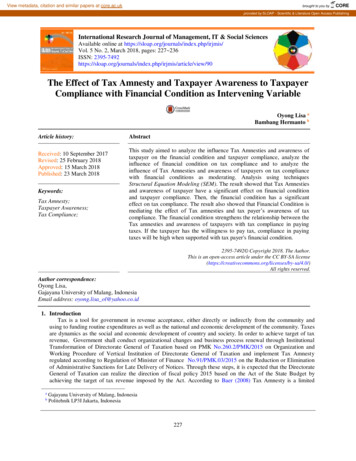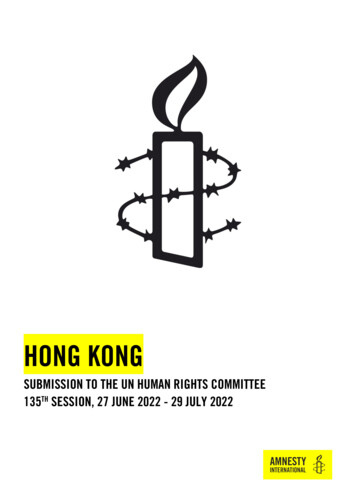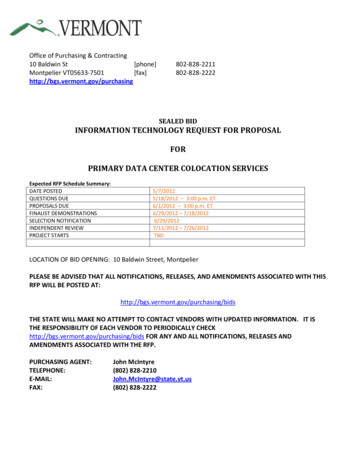
Transcription
Amnesty International 2012 Report toINGO Accountability Charter usingGRI NGO Level C reporting templateName of organization:Filled in by:Name:Clare DoubePosition:Director, Strategy and EvaluationEmail:Clare.Doube@amnesty.orgPhone number: 44 20-7413-5920After you complete this, send a copy to GRI at:Global Reporting InitiativeP.O. Box 100391001 EA AmsterdamEmail: guidelines@globalreporting.orgFax: 31 20 531 0031Information on numbering: All sections in the boxes are taken directly from the original English version ofthe NGO Sector Supplement and the original reference numbers and page number appear in parenthesis.The NGO Sector Supplement is available for free downloading at www.globalreporting.org.
1 Strategy and Analysis 1.1 Statement from the most senior decision-maker of the organization. [GRI NGOSS: p. 25] AMNESTY INTERNATIONAL continues to take its commitment to accountability seriously.Accountability is at the heart of the core work we do – human rights – and we know that it’s essentialfor our credibility as well as to make our work as effective as possible that we embed policies andprocesses that make accountability real. As all INGOs know, this is easier said than done; and is anon-going challenge to do in a meaningful way. We continue to make progress, but as always, there ismore to do.During 2011, we continued our work with and for individuals and communities around the globewhose rights are violated or at risk of violation. We work within the directions set by our membersthrough the Integrated Strategic Plan 2010 – 2015 and other working documents such as the GlobalPriority Statement and operational plans. We aim to balance this planned work with maintainingflexibility to be responsive to emerging situations such as the Arab Spring. In addition to respondingto violations in the short-term associated with this transition in the Arab world we also aim toleverage these opportunities to engender longer-term human rights improvements.Some key achievements for the year include:- Powerful reports on Tunisia, Egypt, Libya and across the Middle East and North Africa region helpedshape the debate and influence the transitions in the region- Advocacy to a powerful UN expert panel on conflict created momentum for accountability withregard to the conflict in Sri Lanka that ended in 2009.- Advocacy on the Arms Trade Treaty paved the way for a 2012 meeting in New York for final treatynegotiations- Increased presence in India and Brazil paved the way for stepped-up activism and campaigning inthese two key countriesAs an organisation, AMNESTY INTERNATIONAL is going through a period of considerable changethat aims to increase our human rights impact and growth, particularly in the Global South. Thestructural changes include moving our centralised work from a single secretariat to distributed hubsin different regions of the world. This will increase our presence in the Global South and enable us towork more closely with rights-holders and local partners, as well as in a more integrated way with ournational entities in the movement.By adopting this new global model, we aim to improve our effectiveness as a global movement(responding to human rights violations with greater speed, relevance and credibility) and make betteruse of resources through a more integrated way of working. These are all essential elements of beingan accountable organisation.This is the largest organisational change in AMNESTY INTERNATIONAL’s history and as such,considerable effort was invested during 2011 on the early establishment stages. This has been slowerthan we expected as a considerable amount of preparation was needed to ensure that our systemsare able to respond to the changed ways of working. We are currently piloting these changes invarious locations and expect the full roll out to begin in 2013.In terms of specific changes related to accountability, a few particular points to highlight from 2011include:Organisational Structure and Processes- Progress: Preparation and planning conducted- Next: Pilot regional hubs and document lessons learned to inform future roll out of new InternationalSecretariat structureImpact Assessment Toolkit- Progress: Toolkit rolled out, training for staff started, impact assessment studies published on ourwebsite- Next: Continue training staff on the participatory impact assessment methods, continue conductingand publishing impact assessment studies
Key Performance Indicators- Progress: Draft indicators developed- Next: Finalise indicators and measurement methods, roll out use and reporting of resultsGender Action Plan and Roadmap for Diversity- Progress: Scoping exercises completed, implementation guidelines drafted- Next: Develop and implement operational plansCarbon Emissions- Progress: Sustained decline in the last 2 years (8% annually on average), largely due to cuttingdown on business travel- Next: Curtail emissions of offices, finalize public statement by the Secretary General, collectmovement’s feedback on draft sustainability policies and guidelinesAnti-Bribery Policy- Progress: Interim policy developed and implemented at the International Secretariat- Next: Support sections and structures to design their own policiesSalil Shetty, Secretary General 2. Organizational Profile 2.1 Name of the organization. [GRI NGOSS: p. 26]AMNESTY INTERNATIONAL 2.2 Primary activities (e.g., advocacy, social marketing, research, service provision, capacity building,humanitarian assistance, etc.). Indicate how these activities relate to the organization’s mission and primarystrategic goals (e.g., on poverty reduction, environment, human rights, etc.). [GRI NGOSS: p. 26] AMNESTY INTERNATIONAL’s vision is of a world in which every person enjoys all of the humanrights enshrined in the Universal Declaration of Human Rights and other international human rightsinstruments. In pursuit of this vision, AMNESTY INTERNATIONAL’s mission is to undertake researchand action focused on preventing and ending grave abuses of these rights. AMNESTYINTERNATIONAL addresses governments, intergovernmental organizations, armed political groups,companies and other non-state actors. AMNESTY INTERNATIONAL seeks to disclose human rightsabuses accurately, quickly and persistently. It systematically and impartially researches the facts ofindividual cases and patterns of human rights abuses. These findings are publicized; and members,supporters and staff mobilize public pressure on governments and others to stop the abuses. Inaddition to its work on specific abuses of human rights, AMNESTY INTERNATIONAL urges allgovernments to observe the rule of law, and to ratify and implement human rights standards; itcarries out a wide range of human rights educational activities; and it encourages intergovernmentalorganizations, individuals, and all organs of society to support and respect human rights.AMNESTY INTERNATIONAL's strategic human rights priorities in 2010-2015 are:(i) Empowering people living in poverty;(ii) Defending unprotected people on the move;(iii) Defending people from violence committed by state and non-state actors; and(iv) Protecting people's freedom of expression and freedom from discrimination.Details on these and other organizational priorities are described in the Integrated Strategic c-plan). Through our work we aim to empower peoplewhose rights are challenged and strengthen the human rights movement.
2.3 Operational structure of the organization, including national offices, sections, branches, field offices, maindivisions, operating companies, subsidiaries, and joint ventures. [GRI NGOSS: p. 26] The AMNESTY INTERNATIONAL movement comprises national sections and structures and theInternational Secretariat. Sections and structures carry out work to promote human rights in theirown countries/territories in accordance with AMNESTY INTERNATIONAL’s ntability/statute-of-amnesty-international). The UKbased International Secretariat provides key research and action functions and coordinatesAMNESTY INTERNATIONAL’s day-to-day work at the global level. Below is the global structure as ofDec 2011. The largest entity of the movement, the International Secretariat, is structured according to thefollowing clusters of work, each headed by a member of the senior management team:(i) Global Operations (to become operational when regional hubs are functioning)(ii) Movement Building (membership, activism)(iii) Campaigns and Communications (global campaigns, media, publishing)(iv) International Law and Policy (thematic coverage)(v) Research (country coverage)(vi) Organizational Services (finance, IT, facilities, legal)(vii) Organizational Development and Human Resources 2.4 Location of organization's headquarters. [GRI NGOSS: p. 26] The International Secretariat (IS) is located at 1 Easton Street, London WC1X 0DW, UK. 2.5 Number of countries where the organization operates. [GRI NGOSS: p. 26] As of Dec 2011 AMNESTY INTERNATIONAL had offices in the following countries/territories:
Global South (48 countries/territories): Algeria, Argentina, Benin, Bermuda, Brazil, Burkina Faso,Chile, Cote D'Ivoire, Croatia, Czech Republic, Faroe Islands, Ghana, Hong Kong, Hungary, India,Israel, Kenya, Lebanon, Malaysia, Mali, Mauritius, Mexico, Moldova, Mongolia, Morocco, Nepal,Paraguay, Peru, Philippines, Poland, Portugal, Puerto Rico, Russia, Senegal, Sierra Leone, Slovakia,South Africa, South Korea, Taiwan, Thailand, Togo, Tunisia, Turkey, Uganda, Ukraine, Uruguay,Venezuela, ZimbabweGlobal North (23 countries): Australia, Austria, Belgium, Canada, Denmark, Finland, France, Germany,Greece, Iceland, Ireland, Italy, Japan, Luxembourg, Netherlands, New Zealand, Norway, Slovenia,Spain, Sweden, Switzerland, UK, USA 2.6 Nature of ownership and legal form. [GRI NGOSS: p. 26] AMNESTY INTERNATIONAL is a worldwide movement based on voluntary membership andcomposed of independent legal entities (national sections and structures) and the InternationalSecretariat. The work carried out through the International Secretariat is organized into two legalentities, in compliance with United Kingdom law. These are Amnesty International Limited ("AIL")and Amnesty International Charity Limited ("AICL"). Amnesty International Limited undertakescharitable activities on behalf of Amnesty International Charity Limited, a registered charity (UKCharity Registration Number: 294230). For charity statuses of sections and structures, contactinformation can be found at national-in-yourcountry. 2.7 Target audience and affected stakeholders. [GRI NGOSS: p. 26] AMNESTY INTERNATIONAL is a worldwide movement of people who campaign for internationallyrecognized human rights to be respected and protected for everyone. We believe human rightsabuses anywhere are the concern of people everywhere. AMNESTY INTERNATIONAL works toimprove people’s lives through campaigning and international solidarity. AMNESTY INTERNATIONALconducts research and generates action to prevent and end grave abuses of human rights and todemand justice for those whose rights have been violated. AMNESTY INTERNATIONAL's membersand supporters exert influence on governments, political bodies, companies and intergovernmentalgroups. AMNESTY INTERNATIONAL's activists take up human rights issues by mobilizing publicpressure through mass demonstrations, vigils and direct lobbying as well as online and offlinecampaigning. 2.8 Scale of the reporting organization. [GRI NGOSS: p. 26] As of Dec 2011, AMNESTY INTERNATIONAL had over 3 million members and supporters (about 87%from the Global North; 56% were women). And we estimate at least 2.5 million individual activistsaround the world took part in actions (traditional methods such as letter writing, signing petitions,demonstrations, lobbying, and other innovative methods such as blogging, social networking, streettheatre and road shows) sponsored by AMNESTY INTERNATIONAL in 2011.We had a total of 2099 staff and 7722 interns/volunteers in 2011 (see Indicator 12, LA1 for furtherdetails). AMNESTY INTERNATIONAL's 2011 global income was 235 million and expenditure was 235 million. AMNESTY INTERNATIONAL's net assets at the end of 2011 were worth 125 million( 172 million of assets, 47 million liabilities) with 62 million in cash.In 2011 AMNESTY INTERNATIONAL organized 202 research missions into the field covering 89countries/territories and logging 5974 person-days.
Please note some countries (e.g., China, Cuba, Iran, Laos, Saudi Arabia, Turkmenistan, Vietnam)prohibit our entry to investigate human rights violations; others make entry for research purposeeither rare or extremely difficult (e.g., India, Syria); and, for some countries, our researchmethodologies mean it is simply too unsafe to enter, both for our contacts in those countries and forour staff.To publicize human rights abuses around the world, AMNESTY INTERNATIONAL published 150reports (10 pages or longer) and 336 shorter documents (country updates, campaign digests, casesheets and leaflets) documenting human rights violations in 114 countries/territories in 2011. Ourannual report on the state of human rights around the world in 2011 was published in May 2012covering 155 countries/territories with over 98% of the world’s population t/2012/introduction). Urgent actions are a longstanding means by which AMNESTY INTERNATIONAL calls for activistaction. They are issued when a person is in imminent danger of human rights abuse and bring publicattention through letter writing. In 2011 AMNESTY INTERNATIONAL issued 729 urgent actions andrelated updates covering 79 countries/territories. 2.9 Significant changes during the reporting period regarding size, structure, or ownership. [GRI NGOSS: p. 26] During 2011, there were no significant changes implemented. However, plans were made for changesto the structure of the International Secretariat (our biggest entity) which are being piloted in 2012 andwill be rolled out in 2013. 2.10 Awards received in the reporting period. [GRI NGOSS: p. 26] None3. Report Parameters
Report Profile 3.1 Reporting period (e.g., fiscal/calendar year) for information provided. [GRI NGOSS: p. 26]Calendar year of 2011. 3.2 Date of most recent previous report (if any). [GRI NGOSS: p. 26] Jan 2012 (2011 Report covering compliance with the INGO Accountability Charter in 2010 using theGlobal Reporting Initiative NGO Level C framework). 3.3 Reporting cycle (annual, biennial, etc.). [GRI NGOSS: p. 26] Annual 3.4 Contact point for questions regarding the report or its contents. [GRI NGOSS: p. 26] Clare Doube, Director of Strategy and EvaluationReport Scope and Boundary 3.5 Process for defining report content. [GRI NGOSS: p. 26]The content we report on is based on the following considerations: (1) INGO Accountability CharterBoard's instructions (Oct 2010 workshop and "Board Meeting Paper ACC 10/21a") requiring allCharter signatories to report compliance with the Charter using GRI Level C template for NGOs with18 indicators (9 are NGO-specific); (2) Charter’s review panel’s feedback to our last year’s report; and(3) key elements of our 2010-2015 Integrated Strategic Plan (see 2.2 above). 3.6 Boundary of the report (e.g., countries, divisions, subsidiaries, leased facilities, joint ventures, suppliers).See GRI Boundary Protocol for further guidance. [GRI NGOSS: p. 26] Unless stated otherwise, this report covers the entire movement of AMNESTY INTERNATIONAL,including all legal entities globally (sections, structures, the International Secretariat). 3.7 State any specific limitations on the scope or boundary of the report. [GRI NGOSS: p. 26] None 3.8 Basis for reporting on joint ventures, subsidiaries, leased facilities, outsourced operations, and otherentities that can significantly affect comparability from period to period and/or between organizations.[GRI NGOSS: p. 27] All legal entities of AMNESTY INTERNATIONAL are expected to adhere to local generally acceptedaccounting principles in preparing their financial reports to the movement and their own
governments. Due to resource and time constraints, it has not been possible to gather sufficientinformation to determine the adjustments required to ensure that the global financial statements arecompliant with International Financial Reporting Standards (“IFRS”). However, we assess this to havean immaterial impact on the overall global accounts. The content and format of the primarystatements (balance sheet and cash flow statement) and supporting notes have been designed toensure compliance with IFRS disclosure requirements where possible. 3.10 Explanation of the effect of any re-statements of information provided in earlier reports, and the reasonsfor such re-statement (e.g., mergers/acquisitions, change of base years/periods, nature of business,measurement methods). [GRI NGOSS: p. 27] 2010 income and expenditure were re-stated to reflect three entities changed their year-ends to 31December in 2010. AI Japan, AI Canada English-speaking and AI UK reported 11 months, 15 monthsand 9 months respectively, for their 2010 income and expenditure. To facilitate year-on-year analysis,2010 figures for these entities had been adjusted to reflect 12 months of activity. The re-stated 2010global income and expenditure were 212 million and 200 million, respectively. All entities havebeen using 31 December as year-ends since 2011. 3.11 Significant changes from previous reporting periods in the scope, boundary, or measurement methodsapplied in the report. [GRI NGOSS: p. 27] None 3.12 Table identifying the location of the Standard Disclosures in the report. [GRI NGOSS: p. 27] This document is the GRI content index for Level C reporting.4. Governance, Commitments, and Engagement Governance 4.1 Governance structure of the organization, including committees under the highest governance bodyresponsible for specific tasks, such as setting strategy or organizational oversight. [GRI NGOSS: p. 27] AMNESTY INTERNATIONAL's highest decision-making body is the International Council, whichconvenes every other year and is made up of representatives of sections and structures andmembers of the International Executive Committee. The primary functions of the InternationalCouncil are:(i) to focus on strategy;(ii) to set AMNESTY INTERNATIONAL’s vision, mission and core values;(iii) to determine AMNESTY INTERNATIONAL’s Integrated Strategic Plan including its financialstrategy;(iv) to establish systems and bodies of governance and delegation for the movement, to electmembers to those bodies, and to hold those bodies and their members accountable;(v) to evaluate the movement’s performance against its agreed strategies and plans;(vi) to hold sections, structures and other bodies accountable.The primary role of the International Executive Committee is to provide leadership and stewardshipfor the whole of AMNESTY INTERNATIONAL worldwide. The functions of the International ExecutiveCommittee are:(i) to take international decisions on behalf of AMNESTY INTERNATIONAL;
(ii) to ensure that there is a sound financial policy for AMNESTY INTERNATIONAL and that thefinancial policy is consistently implemented across the international organization;(iii) to ensure implementation of the Integrated Strategic Plan;(iv) to make any necessary adjustments to the Integrated Strategic Plan and other decisions of theInternational Council;(v) to ensure compliance with the Statute;(vi) to ensure human resources development;(vii) to hold sections, structures and other bodies of AMNESTY INTERNATIONAL accountable for theirfunctioning by presenting reports to the International Council;(viii) to perform the other functions conferred on it by the Statute.The primary functions of the Chairs Assembly (formerly Chairs Forum) are:(i) to give advice and recommendations to the AMNESTY INTERNATIONAL movement and theInternational Executive Committee on matters related to the governance of AMNESTYINTERNATIONAL and controversial issues;(ii) to contribute to building the capacity of Chairs of sections, structures and other bodies ofAMNESTY INTERNATIONAL;(iii) to build relations among sections and structures and provide an open space for debate oncommon issues;(iv) to undertake other tasks and make decisions delegated to it by the International Council.The following committees report to the International Council:(i) Membership Appeals Committee(ii) International Nominations Committee (identifying candidates for all international positions)The following committees report to the International Executive Committee:(i) Governance Committee (governance reform)(ii) Board Development Committee (governance capacities)(iii) Remuneration Committee (executive pay oversight)(iv) Finance and Audit Committee (financial oversight - includes two directly elected members whocan report directly to the council 4.2 Indicate whether the Chair of the highest governance body is also an executive officer (and, if so, theirfunction within the organization's management and the reasons for this arrangement). Describe the divisionof responsibility between the highest governance body and the management and/or executives.[GRI NGOSS: p. 27] The Chair of the International Council is non-executive and appointed by the previous InternationalCouncil Meeting. Members of the International Executive Committee are non-executive and elected atInternational Council Meetings. The day-to-day affairs of AMNESTY INTERNATIONAL are conductedby the International Secretariat headed by a Secretary General under the direction of the InternationalExecutive Committee. 4.3 For organizations that have a unitary board structure, state the number of members of the and/ornon-executive members highest governance body that are independent and/or non-executive members.[GRI NGOSS: p. 27] The current International Executive Committee has 10 unpaid non-executive members (9 elected and1 co-opted). Details of these 10 International Executive Committee members can be found /international-executive-committee. 4.4 Mechanisms for internal stakeholders (e.g., members), shareholders and employees to providerecommendations or direction to the highest governance body. [GRI NGOSS: p. 27]
Members and staff can provide recommendations and feedback directly to the International ExecutiveCommittee at IEC@amnesty.org. The majority of members' recommendations are channelledthrough their section/structure's representatives to the bi-annual International Council Meetings.Key topics discussed at the last International Council Meeting in Aug 2011 were:- Detention or imprisonment of conscientious objectors- Children’s rights- Climate change and human rights- Rights to access to life-saving drugs (AIDS) and medical procedures (abortion)- Strategy of country and thematic coverage- Policy for accepting government funds- Strengthening partnerships between local groups of different national entities- Implementation of Gender Action Plan and Roadmap for Diversity- Payments to former Secretary General and former Executive Deputy Secretary General- Development of global operational and governance standards- Establishing new entities in countries with no physical presence- Defining the authority of the International Executive Committee in case of crisis of a national entity- Inclusion of external governance experts- Clarification of International Executive Committee nomination and election processes- Implementation of a 2-year “cold” period between being board member and senior salaried staffThe movement also routinely consults members and staff on key policies and strategies between biannual International Council Meetings using a wide range of channels from formal submissions toface-to-face forums.Stakeholder Engagement 4.14 List of stakeholder groups engaged by the organization. [GRI NGOSS: p. 29] AMNESTY INTERNATIONAL's key stakeholders are individuals at risk, human rights defenders, nongovernmental and community organizations and coalitions, members and supporters, activists,volunteers, governments and international organizations such as the United Nations. 4.15 Basis for identification and selection of stakeholders with whom to engage. [GRI NGOSS: p. 29] Individuals, defenders, groups or communities that we work with (arising from human rightsviolations or threats that they have experienced) are identified through our research, contacts andpartners at national level. In the first instance this is usually by the country team of the InternationalSecretariat, or by our section/structure colleagues.Country-level strategic partners are identified and supported by the country team and the strategicpartnerships team. The criteria for relationships are based on our shared human rights priorities andagreed plans for joint work that is mutually reinforcing and of real added value to the partners and thehuman rights goals we share.We target key governments and intergovernmental organizations to either put pressure on them topromote human rights or to expose how their actions undermine respect for human rights. We workwith key international and regional human rights bodies and mechanisms such as the United Nations(UN) Human Rights Council, UN treaty bodies and special procedures and the regional human rightscourts and mechanisms. Additionally we work with political and legal bodies such as the UN SecurityCouncil and the International Criminal Court as well as the European Union, Council of Europe,ASEAN and Arab League. Our engagement with each of these institutions is based on our prioritiesand assessment of the impact these institutions can have in the promotion of human rights.
Data on PerformanceIndicator 1: (NGO1) Involvement of affected stakeholder groups in the design, implementation,monitoring and evaluation of policies and programs.AMNESTY INTERNATIONAL identifies its primary stakeholders as those individuals at risk of gravehuman rights violations anywhere in the world and we strive to increasingly include them in our workacross different parts of the organization.For AMNESTY INTERNATIONAL, “active participation is an empowering and enabling processthrough which rights holders participate in and influence the processes and decisions which affecttheir lives in order to gain recognition and attainment of their human rights.” In 2011, we finalized thisworking definition of active participation, developed during 2010, and circulated it across themovement.Active participation is important in how we strategically understand and design our work. Promotingactive participation is not only a key direction of the Integrated Strategic Plan (ISP, 2010-2015) butalso a cross cutting theme under the Global Priority Statements (GPS, 2010-2011, 2012-2013).In practice, the International Secretariat project management methodology encourages all staff toconduct participatory exercises with affected stakeholder groups, at the planning stage of a project,during periodic organizational review times and during evaluation exercises. We actively encourageengagement with the partners and communities we work with so that they are consulted on plans,and involved in reviews and evaluations; although the extent of this varies across different teams andalong a spectrum from consultation to participative processes.Our human rights research has always relied on the participation of local partners; and consultationwith our partners about research and advocacy goals has necessarily informed our researchdecisions. Although fully participatory research is not envisioned, we have been moving towardsusing a much broader range of participatory approaches in the design, implementation, andevaluation of research projects. The Research and Crisis Response Program has produced guid
- Advocacy on the Arms Trade Treaty paved the way for a 2012 meeting in New York for final treaty negotiations - Increased presence in India and Brazil paved the way for stepped-up activism and campaigning in these two key countries As an organisation, AMNESTY INTERNATIONAL is going through a period of considerable change
